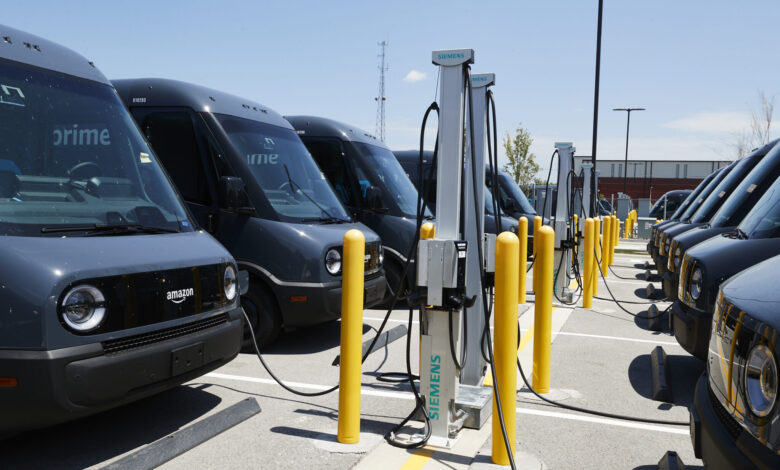Where do Harris and Trump stand? • Nebraska Examiner

Editor’s note: This is part of a series of reports from U.S. newsrooms on key policy issues in the presidential campaign.
Joe Biden highlighted climate change as one of the major crises facing the United States during his 2020 campaign, but it has received far less attention in the 2024 presidential campaign.
Both candidates, Republican former President Donald Trump and Democratic Vice President Kamala Harris, share the twin goals of lowering energy costs and growing U.S. jobs in the industry, but they differ on their plans to achieve that goal. Big disagreement.
On the campaign trail, they spent little time detailing their plans, instead criticizing the other side for extremes.
Harris favors expanding the development of renewable energy sources that provide electricity without producing carbon emissions, a major driver of climate change.
She touted her decisive vote in the U.S. Senate to pass the Inflation Cut Act, a sweeping domestic policy law pushed by Democrats along party lines that included hundreds of millions of dollars in clean energy tax credits.
Trump supports fossil fuel production and blames rising energy prices on policies that support renewable energy. He called for bans on new oil and gas exploration to be lifted to increase the supply of cheap fuel and reduce costs.
Commitment: Promote fossil fuels
Both candidates promise to lower energy costs.
For Trump, that involves slamming the Biden-Harris administration for encouraging renewable energy production.
Trump said at a press conference on September 26 that inflation was caused by “the stupid spending of the Green New Deal, which it turns out is a Green New Scam.” “Have you noticed that they don’t mention environmental issues anymore? What’s going on with the environment?
The former president said during a Sept. 25 campaign event that he would “cut energy (costs) in half” through reduced regulations and tax cuts.
He has not yet laid out detailed plans to achieve this goal.
Implicit in Trump’s argument is that the Biden administration’s focus on renewable energy has hampered oil and gas production, limiting supply and driving up prices.
But Harris said her support for renewable energy models is part of a broader portfolio that includes fossil fuels.
Harris emphasized that the Inflation Reduction Act opens up new leases for oil and gas production while providing incentives for wind and solar energy.
“I’m proud that over the last four years, as vice president, we’ve invested trillions of dollars in the clean energy economy while we It has also increased domestic natural gas production to historical levels.
one Report Data released this month by the U.S. Energy Information Administration show that U.S. fossil fuel production reached an all-time high in 2023.
Commitment: Promote renewable energy
Harris also pointed to IRA provisions that offer consumers tax breaks on green technology such as home heat pumps as a way to reduce costs.
“More than 3.4 million American households will save $8.4 billion in 2023 thanks to tax credits for home energy technology in the Inflation Cutting Act,” her campaign wrote in the 82-page economic plan. .
Trump has also said he supports some climate-conscious technologies, including megadonor Elon Musk’s Tesla-branded electric cars, but that Democrats are overinvesting in non-fossil fuels.
He called elements of the Inflation Reduction Act a “giveaway” and said spending on electric vehicle charging infrastructure is wasteful.
Promise: Restoring jobs
Biden has long talked about the benefits to American workers of transitioning away from fossil fuels, putting them at the forefront of a growing industry.
Harris also framed the issue from an economic perspective, saying the Inflation Reduction Act and other climate policies create jobs.
“During my time as vice president, we created more than 800,000 new manufacturing jobs,” she said during the Sept. 10 debate. “We’ve invested in clean energy to the point where we’re opening factories around the world.”
During a campaign event in Pittsburgh, Pennsylvania, this month, Harris said Trump’s focus on fossil fuels would hinder job growth and said he would “send thousands of high-paying clean energy jobs overseas.”
Trump and his running mate, Ohio Sen. J.D. Vance, said Democrats’ focus on renewable energy limits existing energy jobs.
“We have great energy workers in Ohio and across the country,” Vance said during an August campaign event in his home state. “They want to earn fair wages and they want to power the American economy. Why don’t we have a president who lets them do that?
“Unleashing America’s energy,” he said. “Drill, baby, drill, let’s turn the page on this madness.”
Promise: Repeal Democrats’ climate law
Trump had harsh words for Democrats’ climate laws, blaming their spending on rising inflation.
“To further defeat inflation, my plan will end the Green New Deal, which I call the Green New Scam. It may be the biggest scam in history,” he told the Economic Club of New York in a Sept. 5 speech.
He said that as president, he would reallocate any unspent funds in accordance with the law.
Trump tries to distance himself from policy blueprint 2025 planwritten by the Heritage Institute.
But there is some overlap between the plans of conservative think tanks and what Trump says he plans to do in his second term in the White House.
Project 2025 calls for repeal of the Inflation Reduction Act, describing it as a subsidy to special interests.
Harris has often cited her decisive vote on the bill and described her plans as president to expand its goals.
Harris’ policy plan says she was “proud” to cast the deciding vote on the climate bill and that as president she will “continue investing in a thriving clean energy economy.”
She added that she would seek to improve spending by cutting regulations “so that clean energy projects can be completed quickly and efficiently in a way that protects our environment and public health.”
